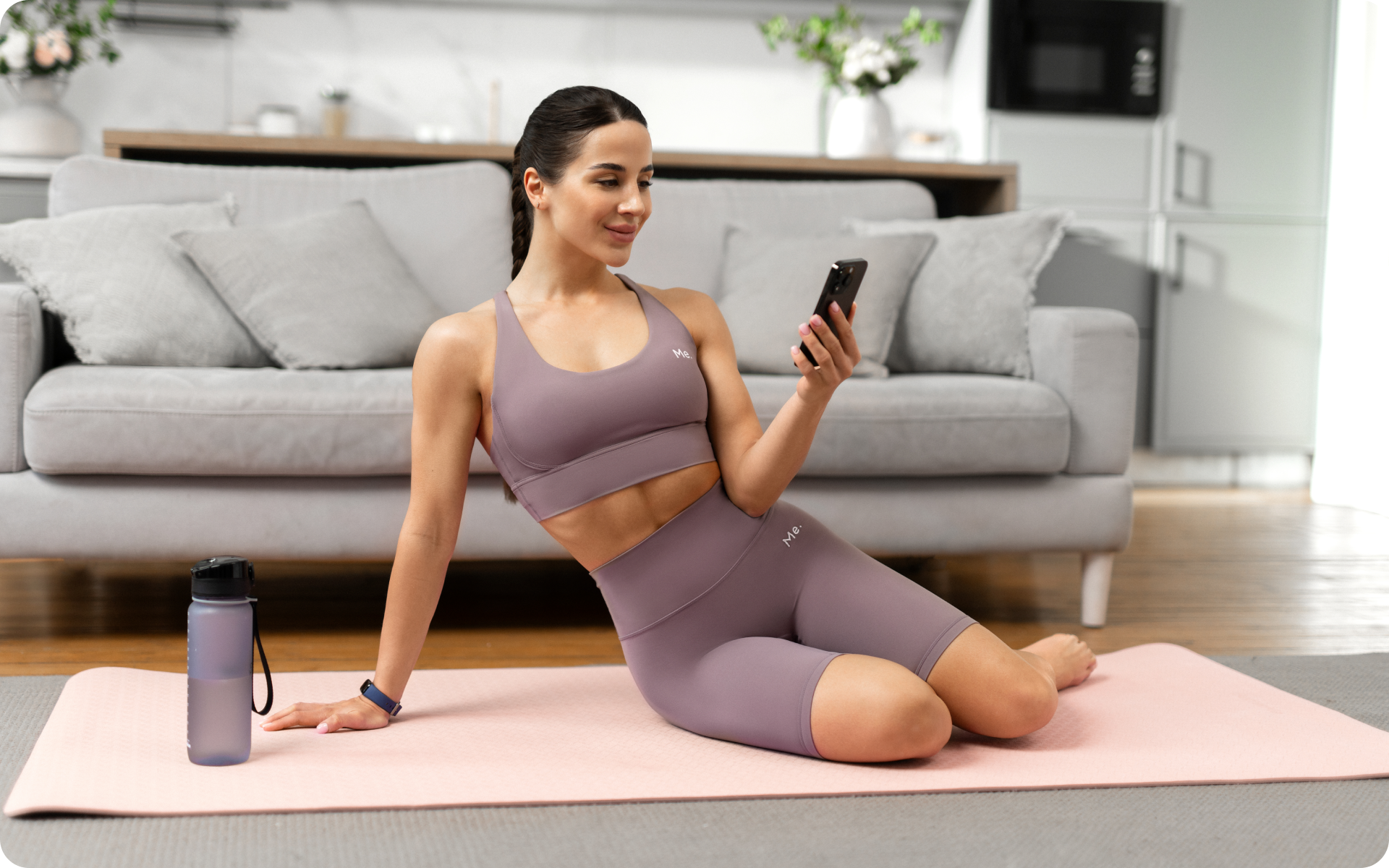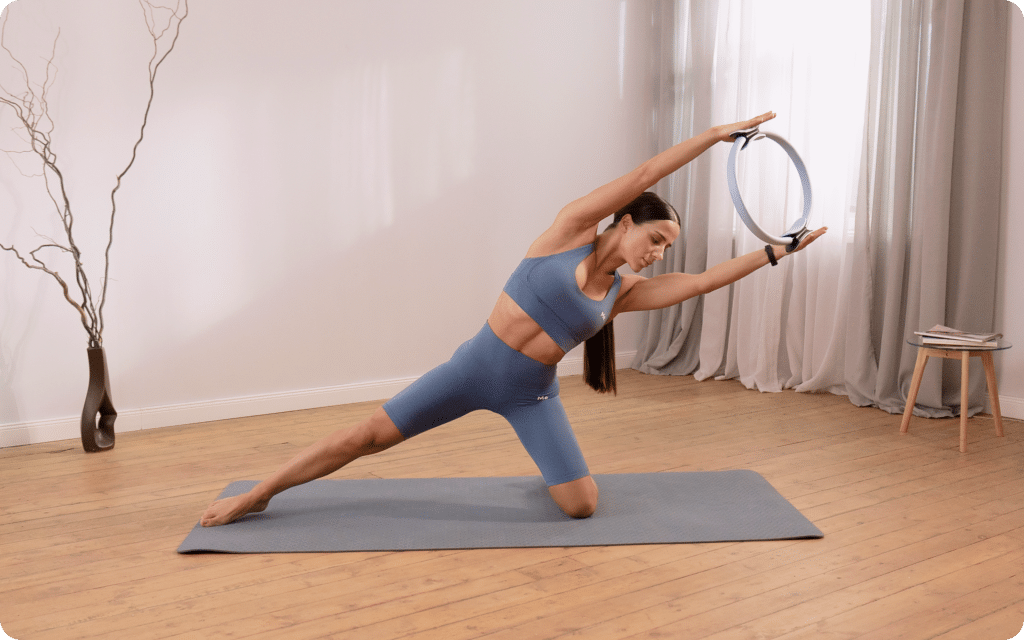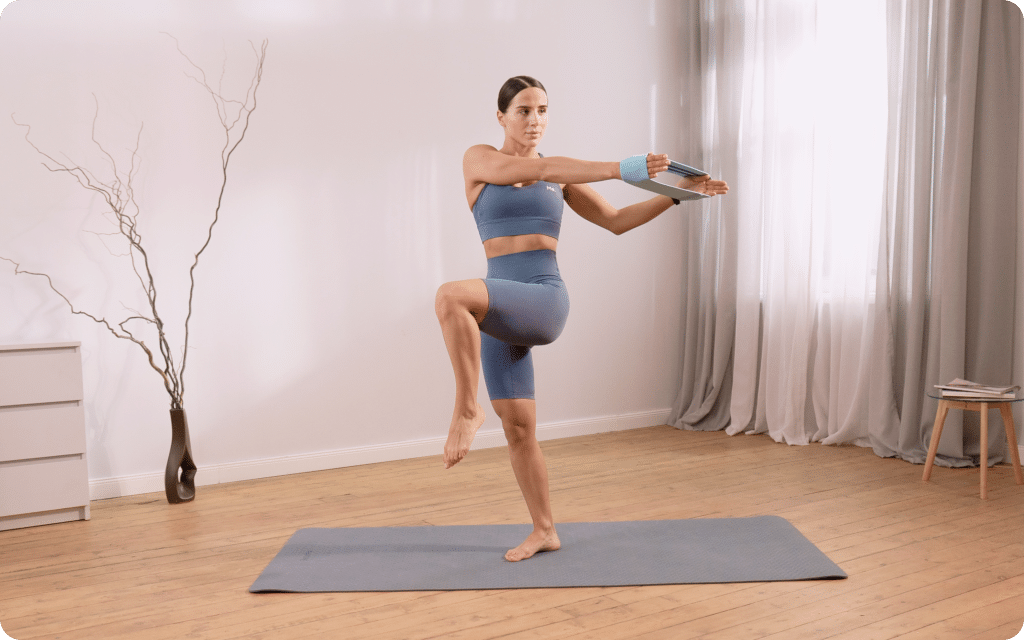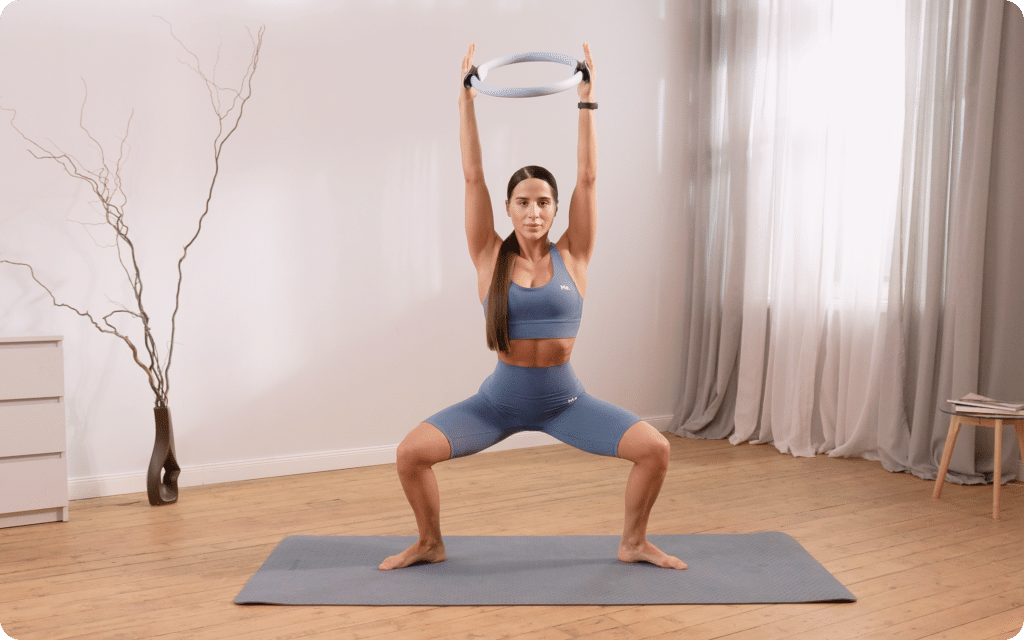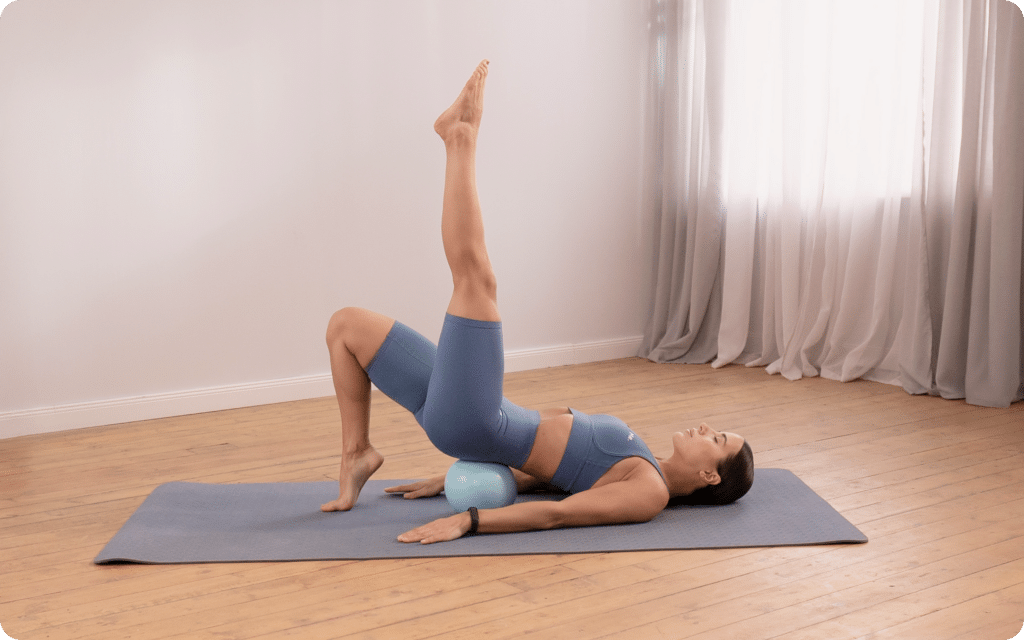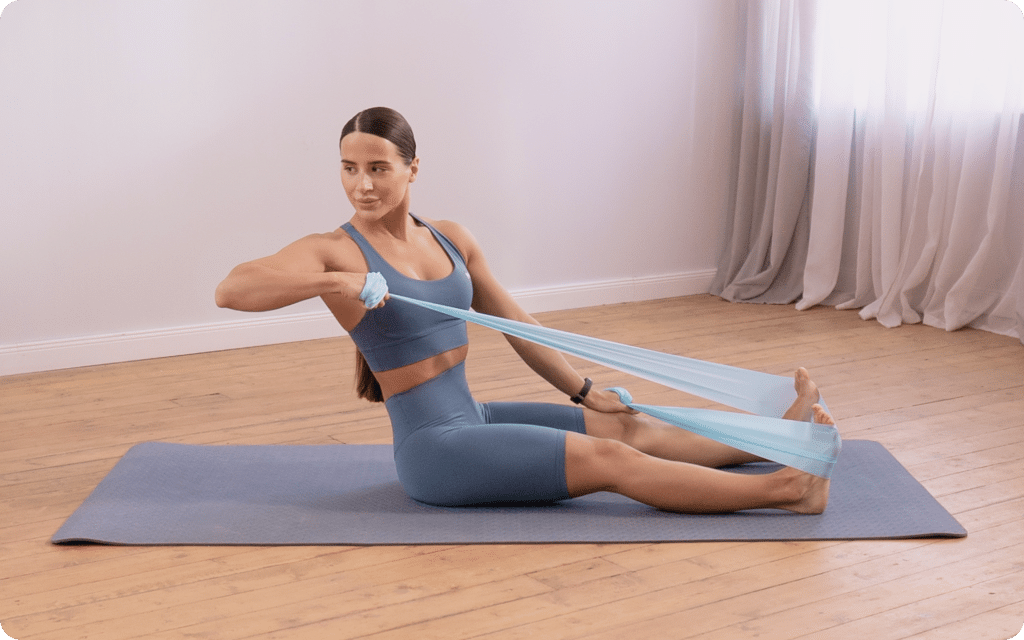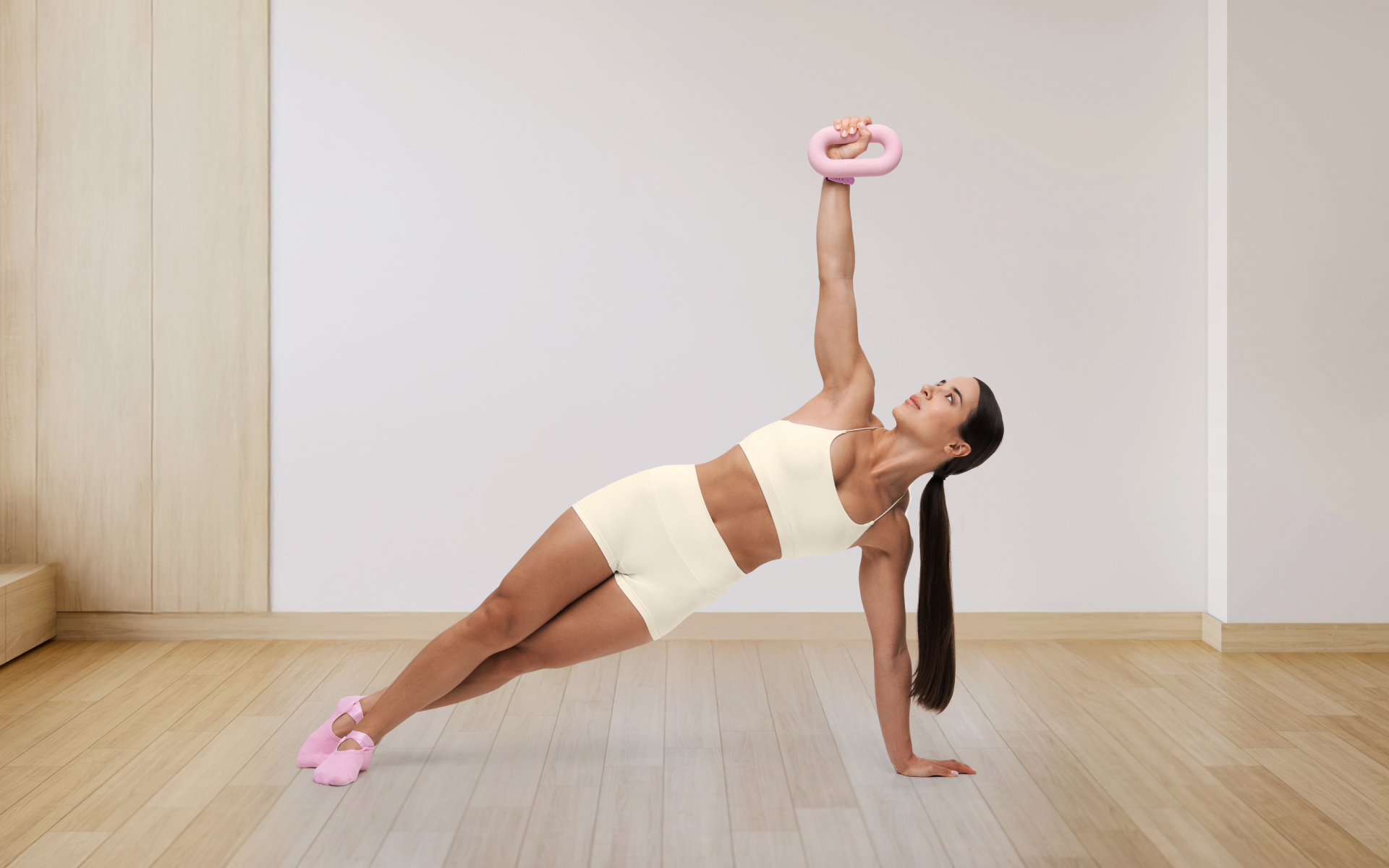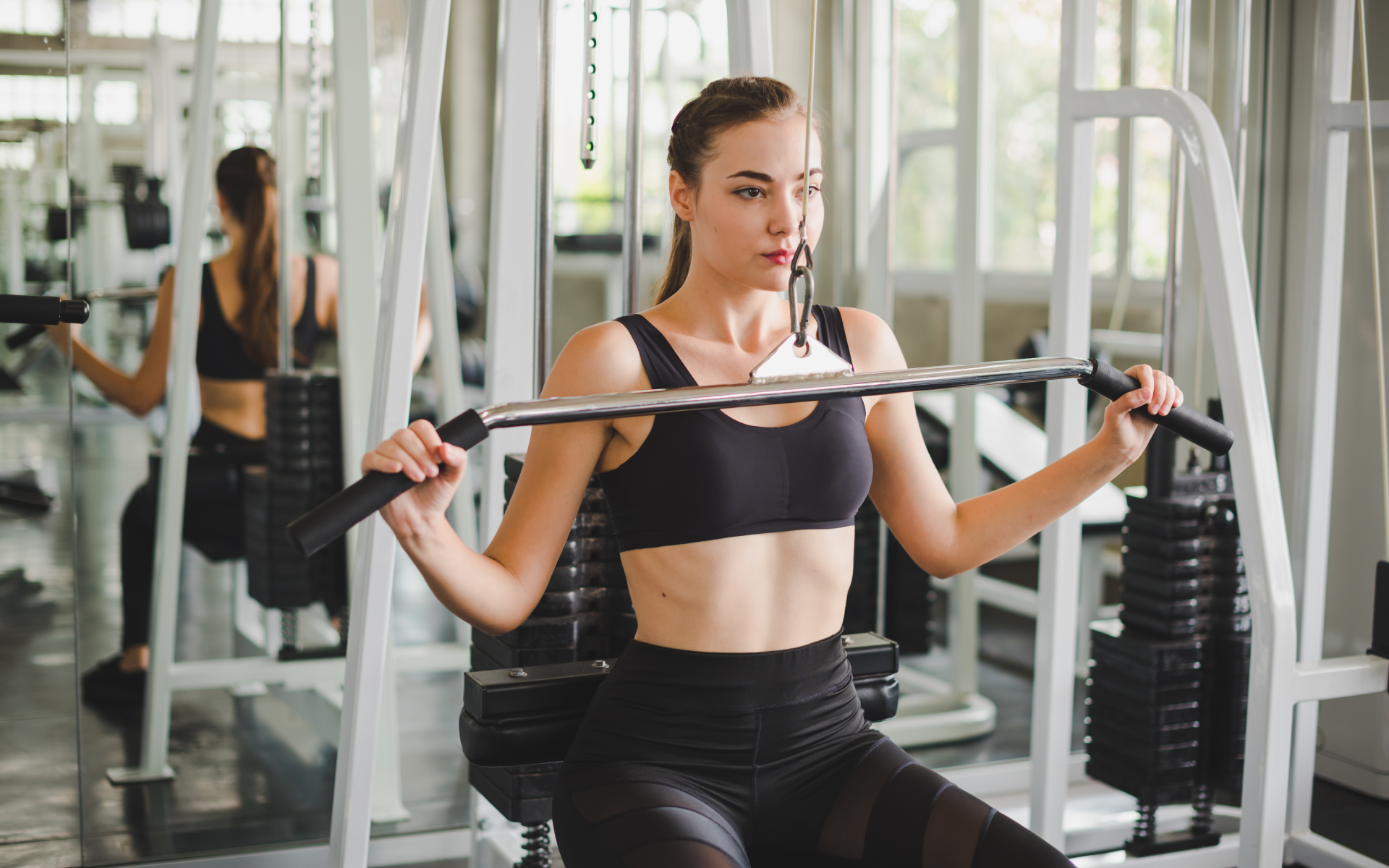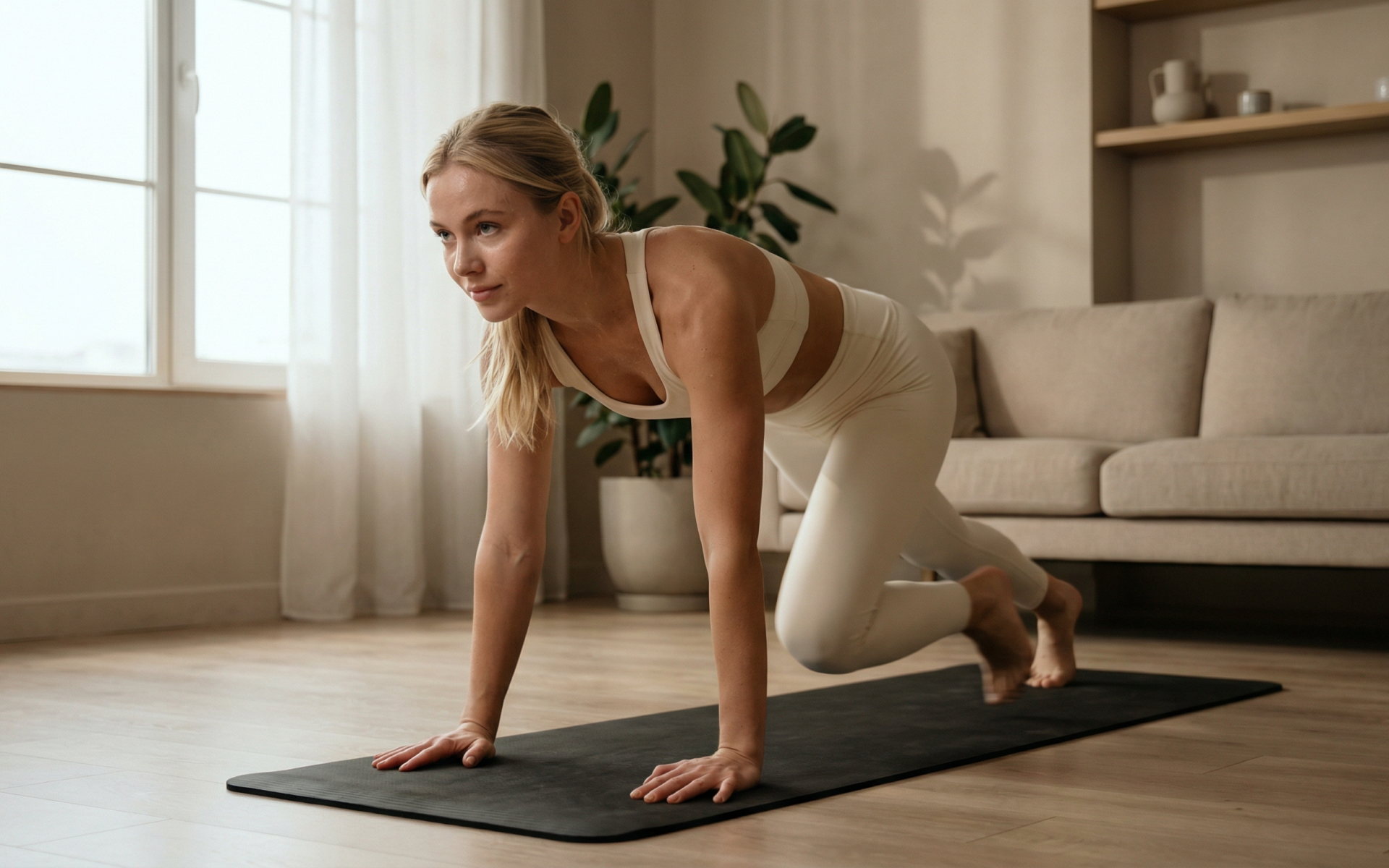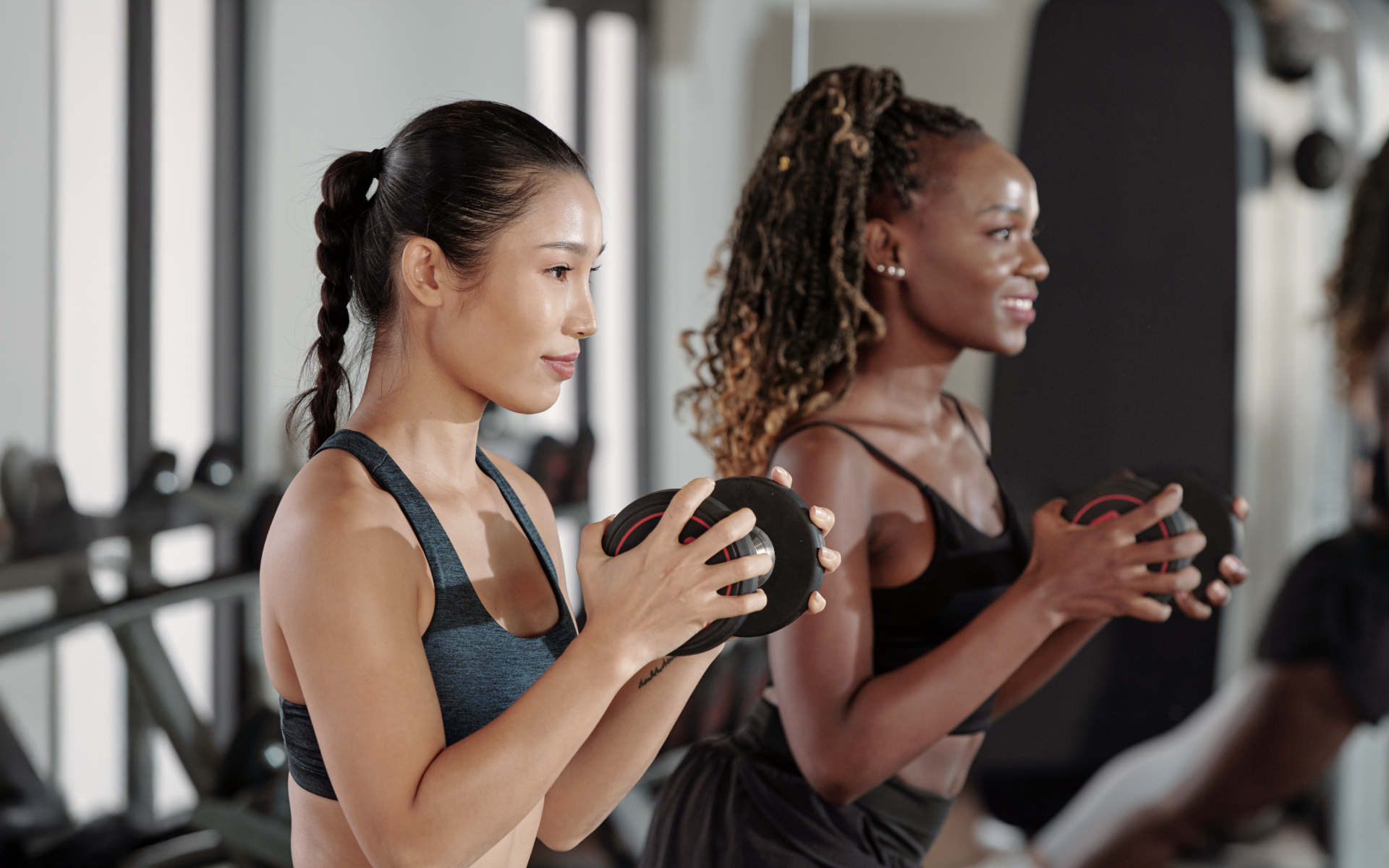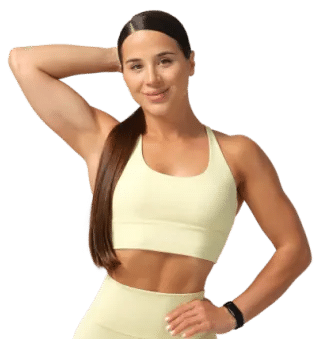Joseph Pilates once said, “Physical fitness is the first requisite of happiness.”
He believed that a healthy, strong body forms the foundation for a vibrant and fulfilling life (2). To him, fitness wasn’t about extremes or chasing perfection. Instead, it was about balance, control, and truly understanding how your body moves.
Mat Pilates embodies this philosophy perfectly. It’s simple, accessible, and highly effective. All you need is a mat and a little motivation to start improving your core strength, flexibility, and overall stability.
This guide is tailored for beginners and focuses on practical floor mat exercises and tips. It’s built with clear, actionable steps to help you incorporate Pilates into your routine.
Whether you’re looking to enhance your posture, reduce tension, or explore a mindful approach to movement, this is a great place to start.
Are Mat Workouts Effective?
A mat Pilates workout for Beginners at home or a gym studio works best as part of a broader fitness routine. Alongside strength and cardiovascular exercises, these workouts bring the following benefits:
Focus On Core Strength And Stability
Joseph Pilates designed his exercises with an emphasis on the core, which he referred to as the “powerhouse” of the body. This core focus includes the abdominals, lower back, hips, and pelvic floor. He believed that strengthening the powerhouse could create a stable foundation for all movement (3).
From an anatomical perspective, a strong core supports the spine and improves posture. Poor core activation can lead to compensations in other muscles, often resulting in pain or injury (4). Pilates’ mat exercises directly target these deep stabilizers, promoting both strength and endurance in ways that are practical and functional for daily activity (5).
Enhancing Flexibility And Posture
One of the standout features of mat Pilates is its focus on spinal articulation and alignment. Joseph Pilates frequently emphasized the importance of a flexible spine, stating that its health reflected one’s overall vitality (3). Mat exercises, such as the Roll-Up or Spine Stretch, aim to improve the range of motion in the spine while promoting proper spinal alignment.
Flexibility, combined with strength, ensures that muscles and joints move efficiently through their intended range. This balance helps reduce stiffness, particularly in individuals who spend long hours sitting or performing repetitive tasks.
From both a biomechanical and holistic perspective, this focus enhances posture and reduces wear and tear on the body (6).
Precision Over Quantity
Joseph Pilates had a distinct approach to movement. He advocated for quality over quantity in exercise (1). Each motion was to be performed with precision, control, and intention. This detailed understanding aligns well with modern perspectives on motor control in exercise science, highlighting the importance of mindful practice for effective neuromuscular development.
Unlike high-repetition workouts, mat Pilates demands focus on form rather than rushing through a series. This deliberate strategy encourages proper muscle engagement and minimizes the risk of injury, particularly for beginners or those recovering from an injury (7).
The BetterMe: Health Coaching app will provide you with a host of fat-frying fitness routines that’ll scare the extra pounds away and turn your body into a masterpiece! Get your life moving in the right direction with BetterMe!
Holistic Mind-Body Connection
Pilates referred to his method as “Contrology.” The name itself highlights the integration of the body and mind (1).
Breathing techniques taught in mat Pilates can:
- Enhance oxygen flow
- Energize the body
- Calm the mind
Modern research supports this concept, as mindful practices can reduce stress and promote better mental focus (8).
Mind-body coordination is not just about fitness but also about improving body awareness. This focus leads to smoother, more efficient movements and improved overall control, which benefits both athletic performance and everyday activities.
Adaptable For All Fitness Levels
One of the reasons mat workouts are so enduring is their accessibility. Joseph Pilates designed these exercises to be scalable.
Whether you are a beginner seeking to build strength or an advanced athlete looking for a challenge, mat Pilates offers something for everyone. It’s a low-impact method that prioritizes movement quality, making it suitable for diverse demographics, including older adults or those managing chronic conditions (9).
From a physiological perspective, scalable resistance or intensity is a key factor in long-term fitness adherence. When coupled with consistent practice, mat Pilates can be progressively adapted to meet new fitness goals.
Promoting Functional Movement
Joseph Pilates deeply emphasized functional movement, not just working out for the sake of exercise, but training the body to move better in real life (1).
Movements like rolling, stretching, and stabilizing mimic actions the body performs daily.
For instance, exercises such as Rolling Like a Ball challenge balance and coordination, components essential for preventing falls or injuries (11).
Improving functional strength through mat Pilates supports daily tasks, from bending and lifting to increased stability during dynamic activities. The versatility of these exercises ensures long-term practical benefits (10).
Read more: Pilates At Home: A 30 Day Challenge To Improve Your Mind And Body
Is Mat Pilates Ok For Beginners?
Mat Pilates is an excellent entry point for anyone starting their fitness journey, including individuals with a more active lifestyle who haven’t tried Pilates before.
Its focus on control, precision, and mindful movement makes it approachable while still offering noticeable improvements in strength, flexibility, and posture.
The workout doesn’t require extreme fitness levels or elaborate at home pilates equipment, making it adaptable for various fitness backgrounds and goals.
There are quite a few reasons why Mat Pilates can be an ideal choice for beginners:
- Low Impact: Mat Pilates is gentle on the joints. This aspect makes it suitable for beginners or those dealing with minor injuries or sensitivities. Movements are controlled and deliberate, reducing the risk of strain or discomfort (7).
- Focus on Technique: Exercises emphasize proper form over speed or heavy effort. This factor enables beginners to establish a solid foundation in movement patterns, which can help prevent injuries in both Pilates and other forms of training.
- Core Strength as a Foundation: Mat Pilates places significant emphasis on strengthening the core muscles. These are the stabilizers of your body, and building core strength is a great way to support functional movement and reduce back pain, even for those already active (5).
- Scalable Intensity: The exercises can be modified to suit different fitness levels. Beginners can start with basic variations and gradually progress to more challenging versions as their confidence and strength grow.
- Improves Body Awareness: Pilates cultivates mindfulness and encourages a deeper understanding of your body. This awareness helps beginners learn how to engage the correct muscles during movements, both in workouts and in daily life (11).
- Requires Minimal Equipment: With just a mat, you can practice beginner mat workouts no equipment, almost anywhere. This simplicity makes it an accessible choice for individuals seeking a low-barrier entry into the fitness world. Beginner mat workouts at home allow you to get started as soon as possible.
- Addresses Posture and Flexibility: Many people, including active individuals, struggle with issues related to posture and flexibility. Mat Pilates directly targets these areas by emphasizing proper alignment and improving joint mobility (13).
- Not Overwhelming: For those new to exercise, starting can feel intimidating. Mat Pilates is structured, disciplined, and calming, offering a welcoming environment to build strength and stamina without feeling overwhelmed.
- Complements Other Forms of Exercise: Even fitness enthusiasts who run, lift weights, or do yoga can benefit from Pilates. It enhances core stability, flexibility, and control, often improving performance in other activities.
Is 20 Minutes Of Mat Pilates Enough?
A well-paced 20-minute Mat Pilates session can be sufficient, especially for beginners or those with a busy schedule.
In his book Return to Life Through Contrology, Pilates highlighted the importance of performing exercises with precision, control, and focus rather than rushing through them or prioritizing duration. His philosophy was rooted in the idea that mindful, deliberate movement yields better results than repetitive, careless effort (1).
While he didn’t specify an exact session length, such as “20 minutes,” his principles suggest that even shorter sessions, if conducted with proper technique and intention, are worth it. This aligns with modern exercise science, which supports the idea that focused, high-quality movement can deliver meaningful benefits in a shorter time frame.
What Are Some Accessible Beginner Mat Workouts?
What are beginner-friendly mat workouts? If you’re new to Mat Pilates, starting with a balanced, full-body routine is a great way to get going. Below is a beginner-friendly workout designed to engage your core, improve flexibility, and build strength.
Take your time and focus on form for the best results. Remember that the best beginner mat workouts will be the ones that fit your life and preferences.
The Hundred
- Lie on your back with your knees bent and feet flat on the mat.
- Lift your legs to a tabletop position with your shins parallel to the floor.
- Raise your head, neck, and shoulders slightly off the mat, keeping your gaze toward your knees.
- Extend your arms alongside your hips, hovering them just above the mat.
- Pump your arms up and down in small, controlled movements while maintaining steady breaths.
- Breathe in for 5 pumps and out for 5 pumps, aiming to complete 10 rounds (100 pumps total).
Single-Leg Stretch
- Stay on your back with your head, neck, and shoulders lifted slightly off the mat.
- Bring both knees into your chest, holding one shin with your hands.
- Extend the other leg out at a 45-degree angle to the floor.
- Switch legs, bringing the opposite knee into your chest as the extended leg bends back to start.
- Continue alternating legs, maintaining a smooth motion for 8-10 repetitions on each side.
Shoulder Bridge
- Lie on your back with your knees bent and feet hip-width apart, flat on the mat. Keep your arms at your sides.
- Press through your feet and lift your hips toward the ceiling, creating a straight line from your shoulders to your knees.
- Engage your glutes and hamstrings as you hold the position for a few seconds.
- Slowly lower your hips back down to the mat.
- Repeat the lift-and-lower motion for 8-10 repetitions.
Side-Lying Leg Lifts
- Lie on one side with your body in a straight line and your bottom arm extended under your head for support.
- Stack your legs on top of each other, keeping your toes pointed.
- Lift the top leg slowly to about hip height and lower it back down with control.
- Keep the movement smooth, and avoid rocking your hips.
- Perform 8-10 repetitions per leg before switching sides.
Swan Prep
- Lie face-down on the mat with your legs extended and arms bent, hands placed under your shoulders.
- Engage your core and press your hands gently into the mat to lift your chest slightly off the ground. Keep your gaze forward.
- Avoid straining your lower back; instead, allow the movement to originate from your upper back and shoulders.
- Lower back down slowly with control.
- Repeat this motion for 6-8 repetitions.
Spine Stretch Forward
- Sit tall on your mat with your legs extended straight in front of you, feet flexed hip-width apart.
- Extend your arms forward at shoulder height, parallel to the floor.
- Slowly round your back and reach forward over your legs, keeping your chin tucked slightly toward your chest.
- Focus on lengthening your spine as you stretch.
- Return to a seated position with a smooth, controlled motion.
- Perform 6-8 repetitions.
How Many Days A Week Should A Beginner Do Mat Workouts?
For beginners, practicing Mat Pilates 2-4 times a week is often ideal.
This frequency is enough to build strength, improve flexibility, and develop coordination, while also giving your body time to recover. Recovery is significant for new movements, as it helps prevent overuse injuries and supports muscle repair (14).
While consistency is key to forming a sustainable routine, intensity also plays a vital role in your progress. For beginners, the focus should be on finding the right balance between the two.
Sessions should be challenging enough to engage your muscles and make gradual improvements but not so intense that they leave you feeling exhausted or sore for days.
Personalizing the intensity to your fitness level ensures that you’re progressing safely and effectively.
A good approach might be starting with 2 or 3 sessions per week to build a habit while keeping the workouts manageable. Once your body adapts, you can gradually increase the intensity or number of sessions to match your growing strength and confidence.
Reasons why BetterMe is a safe bet: a wide range of calorie-blasting workouts, finger-licking recipes, 24/7 support, challenges that’ll keep you on your best game, and that just scratches the surface! Start using our app and watch the magic happen.
Can You Get In Shape Just Doing Mat Workouts?
While mat workouts are great for overall wellness, they may not cover all aspects of fitness. For example, they typically don’t include high-intensity cardio, which is essential for improving heart health. If running, cycling, or other forms of cardiovascular exercise aren’t part of your routine, you might need to add some cardio sessions to balance out your fitness plan.
Similarly, if your goal is significant muscle growth or advanced strength training, mat workouts alone might not be enough. They can help you build endurance and tone, but heavier resistance training, involving weights or resistance bands, is more effective for developing larger muscle groups.
That said, mat workouts are a great addition to any exercise routine, as they can improve balance, flexibility, and core strength. Plus, they offer low-impact options for those with joint issues or injuries.
Read more: Home Pilates Workout Guide: Strengthen Your Core
How Long Until I See Results From Mat Workouts?
- During the first couple of weeks, you may notice feeling more energized after your workouts. You may become slightly more aware of your posture and breathing, and your body may start to loosen up, especially if you’ve been feeling tense or stiff.
- Within 6-8 weeks, you may begin to notice some changes in your body. Your core strength will likely improve, and you might notice increased flexibility and balance during your workouts.
- Within 3 months, consistent mat workouts can lead to visible changes in muscle tone. You’ll likely feel stronger and more toned, especially in your abs, glutes, and legs.
Your fitness level when you begin also plays a role in your results timeframe.
Someone with a sedentary lifestyle may notice improvements sooner because their body is adapting to the new activity of mat exercises for abs, glutes, legs, and other areas.
For those with prior exercise experience, changes may be more gradual.
With all of this, results in the fitness world come with consistency. Consistency with both your exercise and your eating habits will lead to results. It might take some time, but focus on finding a win each day, and you will be where you want to be in no time.
Yes, Pilates can help tone and strengthen your glutes because many exercises specifically target these muscles, such as bridges or leg lifts. However, it focuses more on improving muscle endurance and control rather than significant muscle growth. For larger muscle gains, you may need to incorporate heavier resistance training. Feeling tired after Pilates is a common occurrence, especially if you’re new to the practice or working particularly hard during a session. Pilates engages muscles you may not use daily, especially your core, which can lead to fatigue. Additionally, deep breathing and focused movements can use more energy than you realize. Yes, rest days are essential. They allow your muscles to recover and adapt, which helps improve strength and prevent overuse injuries. Beginners should aim for 2 to 4 sessions per week, with at least one rest day in between each session. Eating after Pilates is beneficial, especially if it is a challenging session. A snack or meal that combines protein and carbohydrates can help replenish energy and support muscle recovery. Aim to eat within 30 to 60 minutes after your workout for optimal results.Frequently Asked Questions
Can Pilates grow glutes?
Why do I feel so tired after Pilates?
Do I need rest days from Pilates?
Should you eat right after Pilates?
The Bottom Line
Beginner mat workouts are a fantastic starting point for anyone looking to improve their strength, flexibility, and overall fitness. They offer a low-impact yet effective way to build core stability, enhance posture, and develop body awareness. While you might not achieve every fitness goal through mat exercises alone, they can form the foundation of a balanced routine.
DISCLAIMER:
This article is intended for general informational purposes only and does not serve to address individual circumstances. It is not a substitute for professional advice or help and should not be relied on for making any kind of decision-making. Any action taken as a direct or indirect result of the information in this article is entirely at your own risk and is your sole responsibility.
BetterMe, its content staff, and its medical advisors accept no responsibility for inaccuracies, errors, misstatements, inconsistencies, or omissions and specifically disclaim any liability, loss or risk, personal, professional or otherwise, which may be incurred as a consequence, directly or indirectly, of the use and/or application of any content.
You should always seek the advice of your physician or other qualified health provider with any questions you may have regarding a medical condition or your specific situation. Never disregard professional medical advice or delay seeking it because of BetterMe content. If you suspect or think you may have a medical emergency, call your doctor.
SOURCES:
- The Science of Pilates Research (2021, ideafit.com)
- Joseph Pilates: The Man Behind The Method That Transformed Movement (2025, pilatesencyclopedia.com)
- Pilates (2011, pmc.ncbi.nlm.nih.gov)
- The real-world benefits of strengthening your core (2012, health.harvard.edu)
- The Relationship of Trunk Muscle Activation and Core Stability: A Biomechanical Analysis of Pilates-Based Stabilization Exercise (2021, mdpi.com)
- Pilates for Improvement of Muscle Endurance, Flexibility, Balance, and Posture (2010, journals.lww.com)
- Is Pilates an effective rehabilitation tool? A systematic review (2018, sciencedirect.com)
- Benefits of Pilates on Depression, Anxiety, and Stress: An Observational Study Comparing People Practicing Pilates to Non-Active Controls (2025, mdpi.com)
- Pilates: how does it work and who needs it? (2011, pmc.ncbi.nlm.nih.gov)
- The Effect of Clinical Pilates on Functional Movement in Recreational Runners (2017, pubmed.ncbi.nlm.nih.gov)
- Pilates Reducing Falls Risk Factors in Healthy Older Adults: A Systematic Review and Meta-Analysis (2021, frontiersin.org)
- The effect of Pilates on body awareness, activity level, aerobic capacity, and balance in healthy young adults (2021, researchgate.net
- Effects of Pilates on Body Posture: A Systematic Review (2024, pmc.ncbi.nlm.nih.gov)
- Recovery in Training: The Essential Ingredient (n.d., unm.edu)
